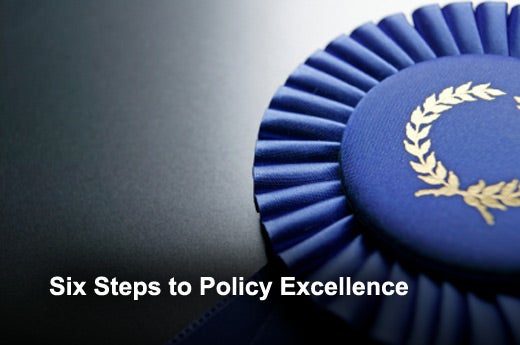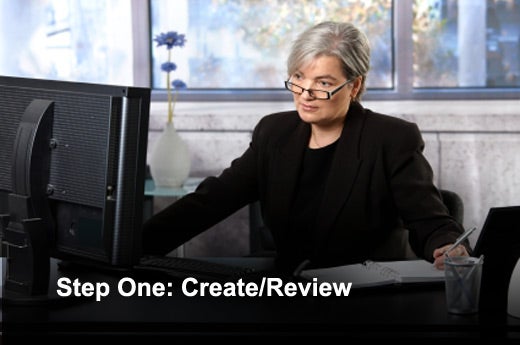Striking the right balance between risk mitigation and the commercial demands of the business is an essential skill, which must be adapted according to the nature of your industry and the size, culture and risk appetite of your organization. This role needs to have clear ownership at senior management level.
Organizations need to take a systematic and proactive approach to risk mitigation if they are to be better prepared to satisfy evolving legal and regulatory requirements, manage the costs of compliance and realize competitive advantage.
Achieving and maintaining policy compliance becomes more difficult to sustain as organizations grow and become more geographically dispersed and more highly regulated. But, it doesn’t have to be this way.
Policies and procedures establish guidelines to behavior and business processes in accordance with an organization’s strategic objectives. While typically developed in response to legal and regulatory requirements, their primary purpose should be to convey accumulated wisdom on how best to get things done in a risk-free, efficient and compliant way.
Those organizations that are serious about staff reading, understanding and signing up to policies should consider adopting automated policy management software. This raises standards of policy compliance and provides managers with practical tools to improve policy uptake and adherence.
This slideshow features six secrets for effective policy management, as identified by Cryptzone.
Click through for six secrets for effective policy management, as identified by Dominic Saunders, a senior vice president at Cryptzone.
It is important to understand, when creating policies, that those created purely to satisfy auditors and regulatory bodies are unlikely to improve business performance or bring about policy compliance, as they rarely change employee behavior appropriately. While satisfying to legal departments, and looking impressive to auditors and regulators, busy employees will instantly be turned off by lengthy policy documents full of technical and legal jargon.
External factors that affect policies are evolving all the time. For example, technology advances may lead to information security policies and procedures becoming obsolete. Additionally, changes in the law or industry regulations require operational policies to be frequently adjusted. Some policies, such as Payment Card Industry DSS compliance, have to be re-presented and signed up to on an annual basis.
Typically, most "policy" documents are lengthy, onerous and largely unreadable – many are written using complex jargon, and most contain extraneous content that would be better classed as procedures, standards, guidelines and forms. Such documents should be associated with the policy. Documents must be written using language that is appropriate for the target audience and should spell out the consequences of non-compliance. Smaller, more manageable documents are easier for an organization to review and update, whilst also being more palatable for the intended recipients. Inadequate version control and high production costs can be reduced by automating the entire process using an electronic system.
A key step in the policy management lifecycle is to ensure that staff are aware of relevant policies and procedures. Organizations need to effectively distribute policies, both new and updated, in a timely and efficient manner. These need to be consistently enforced across an organization. After all, what is the point of expending considerable effort and cost to write and approve policies, if they are not effectively distributed and read?
In many cases, regulatory requirements call for evidence of policy acceptance, demanding a more proactive and thorough approach to the policy management lifecycle.
A process needs to be implemented that monitors users’ response to policies. Policy distribution should be prioritized, ensuring that higher-risk policies are signed off earlier by users than other lower-risk documents. For example, an organization may want to ensure that a user signs up to their Information Governance Policy on the first day that they start employment, while having up to two weeks to sign up to the Travel & Expense Policy. Systems need to be in place to grant a user two weeks to process a particular document, after which the system should automatically force the user to process it.
To monitor and measure staff comprehension and effectiveness of policies and associated documentation, organizations should test all, or perhaps a subset of, users. Any areas that show weaknesses can be identified and corrected accordingly. Additional training or guidance may be necessary or, if it’s the policy that is causing confusion, it can be reworded or simplified.
In many cases, regulatory requirements call for evidence of policy acceptance, which demands a more proactive and thorough approach to the policy management lifecycle. The full revision history of all documents needs to be maintained as well as who has read what, when and, if possible, how long it took, and who declined a policy and why. This record should be stored for future reference and may be stored in conjunction with test results.
To effect change and improve compliance, it helps if key performance indicators relating to policy uptake are clearly visible across all levels of an enterprise. Dashboard visibility of policy uptake compliance by geographical or functional business units helps to consolidate information and highlights exceptions.
Being able to quickly drill down for specific details in areas of poor policy compliance dramatically improves management’s ability to understand and address underlying issues.









